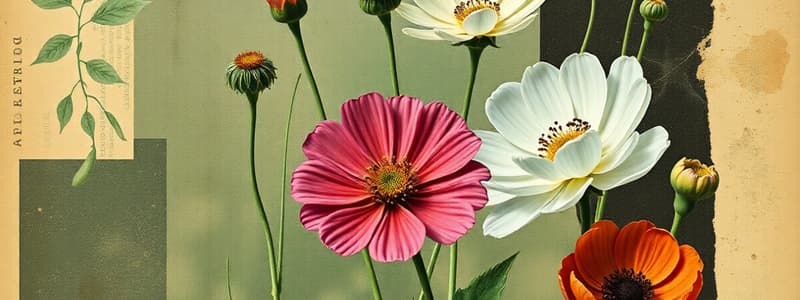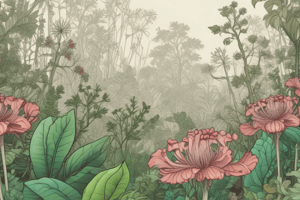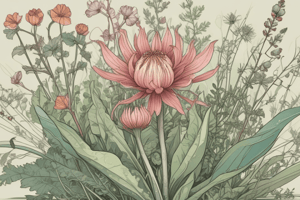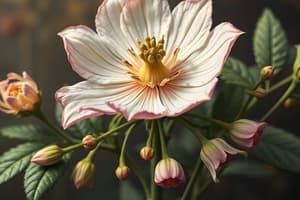Podcast
Questions and Answers
Which of the following traits is NOT an apomorphy (derived trait) of angiosperms?
Which of the following traits is NOT an apomorphy (derived trait) of angiosperms?
- Wind pollination (correct)
- Double fertilization with triploid endosperm
- Flowers
- Carpels
What is the primary function of the brightly colored petals (corolla) in many angiosperm flowers?
What is the primary function of the brightly colored petals (corolla) in many angiosperm flowers?
- Protection of the developing ovules
- Attracting pollinators (correct)
- Providing structural support to the flower
- Enhancing wind dispersal of pollen
Which of the following statements best describes the evolutionary trend of pollination in angiosperms compared to gymnosperms?
Which of the following statements best describes the evolutionary trend of pollination in angiosperms compared to gymnosperms?
- Angiosperms primarily rely on wind pollination, while gymnosperms utilize animal pollination.
- Both angiosperms and gymnosperms rely exclusively on wind pollination.
- Angiosperms ancestrally utilized animal pollination, while gymnosperms are exclusively wind-pollinated. (correct)
- Angiosperms and gymnosperms both evolved animal pollination independently and simultaneously.
A botanist discovers a new species of flowering plant with a strong, fetid odor. Which of the following pollinators is it MOST likely to attract?
A botanist discovers a new species of flowering plant with a strong, fetid odor. Which of the following pollinators is it MOST likely to attract?
What is the function of the carpel in angiosperms?
What is the function of the carpel in angiosperms?
What is the likely outcome if a plant exhibits self-incompatibility?
What is the likely outcome if a plant exhibits self-incompatibility?
What is the primary function of a fruit?
What is the primary function of a fruit?
During double fertilization in angiosperms, one sperm cell fuses with the egg cell to form a zygote. What does the other sperm cell fuse with?
During double fertilization in angiosperms, one sperm cell fuses with the egg cell to form a zygote. What does the other sperm cell fuse with?
Which of the following is the MOST likely advantage conferred by an extra set of genes in plants?
Which of the following is the MOST likely advantage conferred by an extra set of genes in plants?
Gymnosperms and angiosperms differ significantly in their reproductive timelines. Which statement accurately describes a key difference?
Gymnosperms and angiosperms differ significantly in their reproductive timelines. Which statement accurately describes a key difference?
The presence of perforation plates is a specialized feature associated with which type of plant cell?
The presence of perforation plates is a specialized feature associated with which type of plant cell?
What structural adaptation contributes to enhanced sugar conduction in angiosperms?
What structural adaptation contributes to enhanced sugar conduction in angiosperms?
In the context of early seed classification, what primary characteristic distinguished dicots from monocots?
In the context of early seed classification, what primary characteristic distinguished dicots from monocots?
Which of the following traits is considered an apomorphy (a derived trait) specific to monocots?
Which of the following traits is considered an apomorphy (a derived trait) specific to monocots?
What is an atactostele, and in which group of plants is it found?
What is an atactostele, and in which group of plants is it found?
Considering the evolutionary trends in plant anatomy, what is implied by the statement 'wood lost!' in the context of monocot stems?
Considering the evolutionary trends in plant anatomy, what is implied by the statement 'wood lost!' in the context of monocot stems?
Flashcards
Angiosperms
Angiosperms
The largest group of land plants, also the most economically important.
Flower
Flower
Modified shoot system bearing modified leaves, including the perianth, stamens and carpels
Flower Pollination
Flower Pollination
Transfer of pollen to the ovule, often facilitated by animals.
Carpel
Carpel
Signup and view all the flashcards
Gynoecium
Gynoecium
Signup and view all the flashcards
Fruit
Fruit
Signup and view all the flashcards
Self-incompatibility
Self-incompatibility
Signup and view all the flashcards
Double Fertilization
Double Fertilization
Signup and view all the flashcards
Extra Genes Advantages
Extra Genes Advantages
Signup and view all the flashcards
Gymnosperm Fertilization
Gymnosperm Fertilization
Signup and view all the flashcards
Angiosperm Fertilization
Angiosperm Fertilization
Signup and view all the flashcards
Angiosperm Vessels
Angiosperm Vessels
Signup and view all the flashcards
Sieve Tube Members
Sieve Tube Members
Signup and view all the flashcards
Vessel & Sieve Efficiency
Vessel & Sieve Efficiency
Signup and view all the flashcards
Dicots
Dicots
Signup and view all the flashcards
Monocots
Monocots
Signup and view all the flashcards
Study Notes
- Angiosperms are flowering plants.
Angiosperm Phylogeny
- Angiosperms are spermatophytes (seed plants) that also include gymnosperms.
- Gymnosperm groups include Conifers, Gnetales, Ginkgo, and Cycads.
- Eustele and vascular cambium are traits of seed plants.
- Leaves evolved to be simple.
- Siphonogamy is the development of non-motile sperm.
- Pollen striate and vessels with perforated walls also appeared.
Key Angiosperm Facts
- The largest group of land plants are Angiosperms.
- The most economically important plants are Angiosperms.
Angiosperm Defining Characteristics (Apomorphies)
- Flowers
- Carpels
- Fruits
- Double fertilization with triploid endosperm
- Specialized conductive cells
Flowers
- Flowers are shoot systems bearing modified leaves.
- Perianth is the term for the calyx and the corolla.
- Calyx (sepals) are green and protective.
- Corolla (petals) are colored and attractant.
- Stamens are the male parts.
- Carpels are the female parts.
- The pistil consists of the stigma, style and ovary
- Flower pollination is the transfer of pollen to the ovule.
- Angiosperms use animal pollination.
- It is ancestral for angiosperms.
- It is a more efficient means of pollen transportation.
- Gymnosperms are wind pollinated.
- Some angiosperms are secondarily wind pollinated.
- Animal pollination strategy:
- Attractant: Large or brightly colored perianth with a sweet or rotten odor.
- Reward: Nectar or pollen is offered, and rarely waxes or oils.
- Pollination mechanisms include insects, birds, bats, water, and wind.
- Insect pollinators include bees, butterflies/moths, and flies.
Carpels
- The female reproductive parts of angiosperms
- Carpel is a conduplicate megasporophyll.
- Conduplicate means folded.
- Megasporophyll is the "female leaf, bearing seeds".
- Carpel encloses ovules and seeds.
- Carpels can fuse together.
- Gynoecium refers to all female parts.
- Pistil consists of the ovary, style, and stigma.
- A pistil can be one carpel or many.
- Carpel function:
- Protects young seeds
- Site of pollen germination and can induce self-incompatibility reactions
- Develops into Fruits
Fruits
- Fruit is a mature ovary plus accessory parts.
- Fruit function is seed dispersal.
- There are fleshy and dry fruit types
- Fleshy fruits are dispersed by animals.
- Dry fruits are dispersed mechanically, by wind or water.
Double Fertilization
- Key process in angiosperm reproduction
- Pollen produces 2 sperm cells.
- If a pollen grain germinates, a pollen tube grows down the style toward the ovary.
- The pollen tube discharges two sperm into the female gametophyte (embryo sac) within an ovule.
- One sperm fertilizes the egg to form the zygote.
- The other sperm combines with the two polar nuclei to form a triploid cell, which develops into the nutritive tissue called endosperm.
- Therefore:
- Sperm (n) + egg (n) --> Zygote (2n)
- Sperm (n) + 2 polar nuclei (n) --> Endosperm (3n)
- Triploid endosperm is nutritive tissue in angiosperm seeds.
- The extra set of genes may help with rapid development and increased genetic variation.
- Fertilization occurs soon after pollination in angiosperms.
- Seeds are produced rapidly for angiosperms.
- This rapid turn around creates selective advantages, specifically for annual herbs.
- Gymnosperms have a long period between pollination and fertilization.
- Seeds of gymnosperms mature slowly, in 1-2 years.
Specialized Conductive Cells
- Most angiosperms have vessels and perforation plates.
- Angiosperms have sieve tube members with sieve plates which are bigger pores in end walls.
- Vessels and sieve tube members are more efficient in water and sugar conduction
Angiosperm Classification
- Old classification:
- Dicots have two cotyledons (seed leaves)
- Monocots have one cotyledon.
- In modern phylogeny, monocots are monophyletic.
- Apomorphies of monocots include 1 cotyledon, atactostelic vasculature, absence of vascular cambium and parallel leaf venation .
- Monocots include palms, orchids, irises, and grasses.
- Traditional "dicots" are paraphyletic.
- Eudicots are pollen tricolpate and monophyletic.
- Eudicots include most angiosperms like roses, legumes, daisies, and oaks.
- All other Angiosperms have pollen with one aperture, whereas eudicots have pollen with three apertures.
Studying That Suits You
Use AI to generate personalized quizzes and flashcards to suit your learning preferences.




